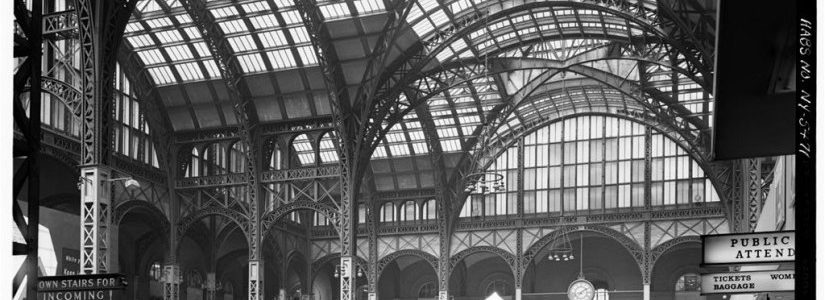
Stanley B. Judd
Action Group for Better Architecture in New York fought to save Pennsylvania Station with the aid of Stanley Judd's appeal to the New York City Planning Commission.
Attorney Stanley Judd lent his legal expertise to the Action Group for Better Architecture in New York (AGBANY), the organization founded in 1962 to oppose the demolition of Penn Station. In this interview conducted in 2003 by Annette Rosen, Judd describes his role in drafting a complaint concerning the demolition to the Public Service Commission (PSC), which at the time was responsible for regulating railroad service. The failure of the PSC and other public agencies to protect the station helped demonstrate the need for landmarks legislation.
Q: Could you please tell us your name and some remarks about your involvement with the demolition of Pennsylvania Station?
Judd: I’d be glad to. My name is Stanley Judd. I became involved because Pennsylvania Station was a grand, dignified, serious and harmonious railroad terminal. I was a young man, born in Brooklyn, who except for my years of college at Cornell [University]. I used Pennsylvania Station to get there and come back—and a judicial clerkship in Oregon following graduation from law school, and for summer vacations, I’d lived all my life in New York. I had never seen anything like Pennsylvania Station. Many years later, I saw some drawings by [Giovanni Battista] Paranesi and they reminded me of the isolated, haunted quiet of its immense and weighty pillars, marbled lobbies, and staircases rising to—or descending into—who knew where? All this was just the introduction to the station, the great interior square under a soaring glass ceiling.
When I learned that an effort was being made to save Pennsylvania Station from being demolished, I offered my help. I really hadn’t remembered much of this until recently, when I was contacted about this commemorative event. I went down to the storage closet in the building that I live in in Washington D.C., and I went through some old files. Files that had followed me from place to place. Looking through these files, I found a file marked AGBANY [Action Group for Better Architecture in New York]. I looked through it and I found letters and other documents concerning the effort by AGBANY to save the station. I’ve given those documents to the New York Preservation Archive Project. One of the things I did, I helped draft a complaint to the Public Service Commission, demanding a hearing on the proposed demolition of Pennsylvania Station. Also, as an attorney for AGBANY, I wrote a brief to the [New York] City Planning Commission, in opposition to the granting of a special permit for an arena of 25,000 seats on the site of Pennsylvania Station. That would be the new Madison Square Garden.
The [New York] Public Service Commission responded to the complaint in a letter that stated that, “To the extent that the complaint was prompted by aesthetic considerations,” which, given AGBANY’s title—Action Group for Better Architecture in New York—the commission assumed was the principal motivation for the complaint. The Public Service Commission concluded that because the motivation was the complaint was aesthetic, the Commission had no power to act in the matter. The letter went on to say that while the Commission, “Of course, was concerned with the adequacy of the service to be rendered to the traveling public,” in the absence of some substantial reduction in such service, the proposal to demolish Pennsylvania Station did not require the Commission’s prior approval.
In other words, the Public Service Commission was of the view that the demolition of a public edifice that gave dignity to travelers, elevated their spirit, and enhanced their departures and arrivals, did not constitute a substantial reduction in the adequacy of the service rendered to the traveling public. That was the attitude of people in the various bureaucracies, and to a large extent, a large part of the public.
Q: Mr. Judd, thank you very, very much for your most sensitive and informative remarks. Do you have any further comments that you want to make?
Judd: The point of the brief to the City Planning Commission was that, in determining whether land, which the Pennsylvania Railroad had been empowered to acquire—solely for railroad purposes—could, some sixty years later, be used for non-railroad purposes. As the site of an indoor sports arena, the Commission was required to consider and weigh every public interest in the continuance of the then current use and form of the site. That is, as Penn Station.
I would just add that the demolition of Pennsylvania Station demonstrated that the then existing law was inadequate to protect the public interest in an effort that had been dedicated to a public purpose and had enhanced the lives of those who had used it. The demolition of Pennsylvania Station gave rise to an organized and sustained public effort to preserve historical landmarks, and to the passage of the [New York] Landmarks Preservation Law. Grand Central Station was saved. Unfortunately, Pennsylvania Station—a building whose like we will not see again—had to be sacrificed for the people to be aware of the significance to their lives of our great buildings and public spaces.
Q: Thank you very much, sir.
Judd: You’re very welcome.
[END OF INTERVIEW]